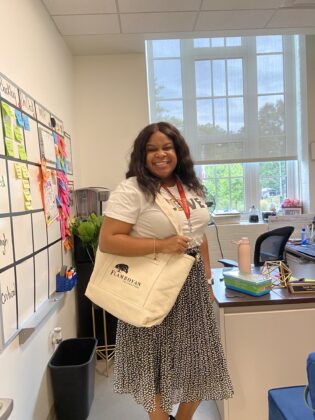If you ask Tarah Galloway about her experience as a parent at John Lewis Elementary School in Washington, DC, she will tell you she’s never had relationships like the one she has now with her child’s teacher and principal. Her daughter, now in the second grade, started Kindergarten at John Lewis during the year of virtual learning – and Tarah felt hesitant about how they would approach connecting with her six-year-old through the computer.
But the school put her at ease, inviting her to a safe, socially distanced outside meet-up so that Tarah could meet several of her daughter’s new teachers face-to-face.
“That visit laid the foundation of me knowing that I have someone here that I trust, someone who has the best interest of my kiddo at heart,” she said. The next year, John Lewis kept students in the same group as they moved to first grade, so they already had relationships with other students and teachers in place as the world moved slowly back to in-person learning.
“They have a clear attitude of: ‘everything is figure-outable.’ I have a relationship with my child’s teacher where I truly feel like I can reach out, and where they want to learn from each family about their child.”
 Tarah spends a lot of time thinking deeply about the importance of family-school partnerships because she too is an educator, currently serving as the Assistant Principal at MacFarland Middle School, just up the street from John Lewis. This year, at Tarah’s urging, MacFarland applied for the Family Engagement Partnership (FEP) at Flamboyan to build their own family engagement practices. In the interview process, she discovered that many of the strategies sounded familiar because John Lewis has been a partner school since 2016, working with Flamboyan on coaching, tools, and strategies to build REAL Family Engagement practices.
Tarah spends a lot of time thinking deeply about the importance of family-school partnerships because she too is an educator, currently serving as the Assistant Principal at MacFarland Middle School, just up the street from John Lewis. This year, at Tarah’s urging, MacFarland applied for the Family Engagement Partnership (FEP) at Flamboyan to build their own family engagement practices. In the interview process, she discovered that many of the strategies sounded familiar because John Lewis has been a partner school since 2016, working with Flamboyan on coaching, tools, and strategies to build REAL Family Engagement practices.
“Part of my draw toward becoming an educator was that as a parent, I saw how children were treated based on how their families engaged – and they tended to be the high-income, more privileged families,” says Nikeysha Jackson, principal of John Lewis Elementary School.
Principal Jackson started with a mindset: families are the experts on their own children, and to know the whole child and grow their learning, educators must learn from families. This means going beyond events to bringing families into what’s happening inside the classroom.
“We are really intentional about how we introduce new strategies and expectations for teachers, so it doesn’t feel like ‘one more thing,’” she says of John Lewis’s approach to building sustainable family engagement practices. The school starts with home visits – like the one Tarah experienced her first year as a John Lewis parent – as a foundation of trust and communication. But they aim for ongoing conversation between families and teachers.
As a parent, Tarah feels that intentionality: she can tell that John Lewis notes when she is able to attend an event or parent-teacher conference and will offer alternative solutions if her schedule prevents her from connecting. While she works up the street at MacFarland, she’s noticed that John Lewis makes huge efforts to involve parents who do not live in the neighborhood, and that they strive to develop relationships with families no matter their schedule, where they live, or the language they speak at home. Principal Jackson noted that growing their strong connections with lower-income and Spanish-speaking families is a priority this year, and that the school is thinking about how to build trust so that families know they have a voice in their child’s education and at the school.
The experience of being a parent at a school practicing REAL Family Engagement inspired Tarah to envision what sustainable and equity-oriented practices might look like at MacFarland.
“They really do think of parents and the local community as extensions of the school. The principal loves to say they ‘turn the school inside out’ – they make supports available that families need,” says Tarah. Her vision is that MacFarland becomes that type of resource for families, particularly as students get older and more independent. In sixth grade, families are still walking their child up to the door of the school building, but by eighth grade it’s changed, and expectations for communication with the school are different.
“How can we make it easy?” Tarah asks. “Parents want to be involved, and we have to let them know they can be.” She is especially eager to find ways to extend sustainable family engagement practices across the whole school, so that every family feels as connected to MacFarland as she does to John Lewis.
“The school must feel empowered in addition to the families,” she says. “Flamboyan is going to help us consider how to make it second nature for families, so parents don’t need to figure it out.”